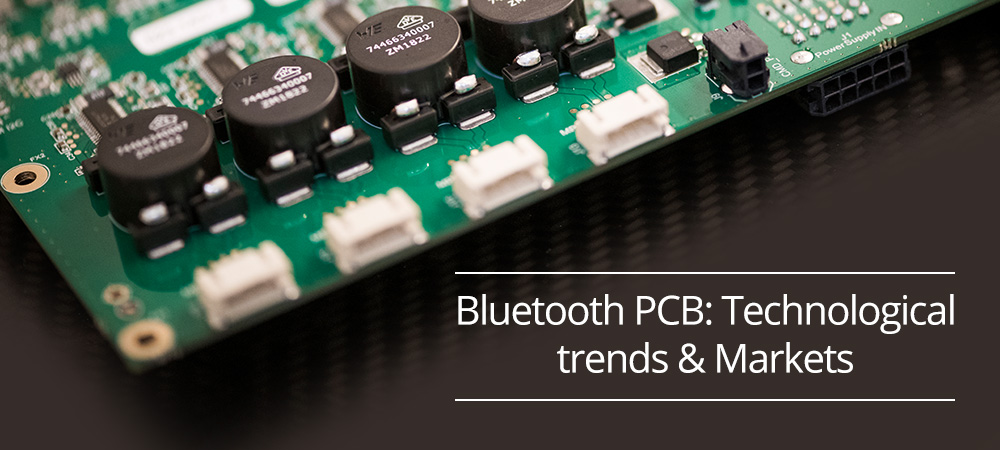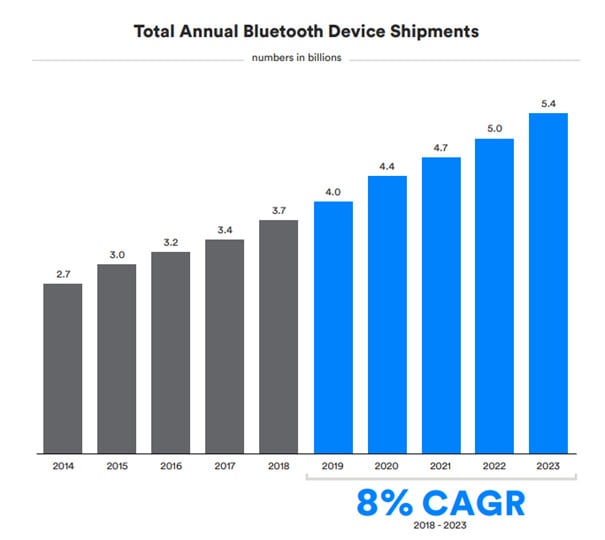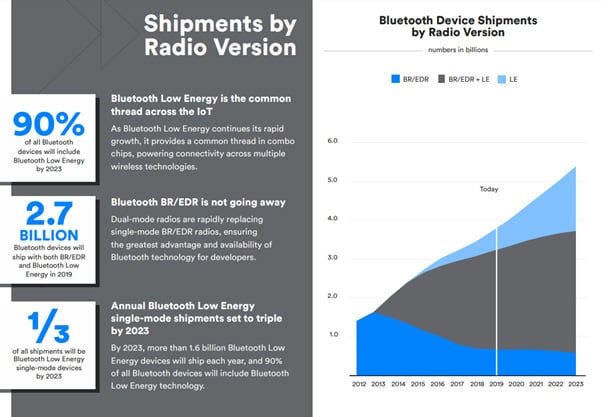
Bluetooth technology has been in existence for about twenty years and is experiencing a genuine revolution with the growth of IoT (Internet of Things) while Bluetooth PCB applications are multiplying. Deployed to meet consumer needs, Bluetooth technological changes have become a growth driver for smart buildings, smart industries or even smart cities.
This is an overview of the latest technological trends and the new Bluetooth PCB market applications.
Bluetooth: history and principle
Bluetooth is an evolution of prior technology that uses infrared, for example remote controls. That system needed to point at a sensor to operate and did not authorise the network connection of several entities. With the arrival of Bluetooth, those limits were removed.
Bluetooth runs on a 2.4 GHz frequency (Ultra high frequency UHF radio waves) and using a “master” device, makes it possible to control up to seven other “slave” devices without a hard-wired connection. These “slave” devices do not communicate with each other and only receive data from the “master”. This is no longer the case for the latests changes to Bluetooth, as we will see later.
In 1994, the Swedish manufacturer Ericsson gave it the name Bluetooth, a name borrowed from the Danish king Harald Bluetooth who had succeeded in uniting several tribes into a single kingdom.
Bluetooth technology: the trends
Bluetooth Low Energy (BLE)
Bluetooth Low Energy – also known as Bluetooth LE or Smart Bluetooth – appeared in 2010 following the deployment of Bluetooth Core Specification version 4.0. Its speed is similar to that of the classic Bluetooth (1 Mbit/s), but its energy consumption is 10 times lower for an equivalent range. Connections can be made immediately and cut as soon as the data transfer is complete. This is how it is possible to design short-range wireless systems that can operate for months or even years using a basic button.
BLE provides a significant reduction in energy consumption and operating costs while maintaining performances, thereby opening the way to Bluetooth meshed networks.
Bluetooth mesh networks
Originally, the number of devices that could be connected to a Bluetooth network was limited to seven devices connected to a “master” system only (and not to each other). This is no longer true.
In a mesh network, instead of a central device communicating with individual peripherals, a message is relayed from one point in the network to another by bidirectional channel hops, thereby connecting several nodes. It has important advantages because it allows the simultaneous control of several dozen connected peripherals, to overcome range limitations and to generate redundancy.
The appearance of Bluetooth Mesh networks was made possible by Bluetooth BR/EDR (transmission of a constant flow of data from point to point between two devices) and Bluetooth Low Energy (transmission of a non-constant flow that is less energy consuming along a point to point or “one-to-many” connection).
This meshing capacity is mainly based on the Bluetooth LE standard, which is designed for the secure and reliable connection of several hundred or even thousand devices together. Ideal for smart buildings, smart industry or smart cities and wherever a stand-alone, smart network is required.
This BLE based technology uses a low bandwidth to send data to create a relay between low consumption devices on a mesh network. Other advantage: mesh networks are ad hoc, simplifying the addition or removal of nodes and only requiring a minor network reconfiguration if at all.
and get your PCBA quote within the next 10 minutes!
Bluetooth 5
Most last generation smartphones have Bluetooth 5. This is the most recent version (2016) of the specifications drawn up by the Bluetooth Special Interest Group (SIG), which are regularly updated by work groups to cover technological changes and market needs.
Bluetooth 5 doubles the range to 200 metres and the transmission flow with BLE is multiplied by four to 4 Mbits for the same energy consumption. Another significant step forward: the reduction of the interferences with Wi-Fi, which uses similar frequencies, previously this could cause interference.
These new specifications will give a new boost to Bluetooth Mesh networks by making it possible to cover an entire industrial building, home or other building.
Web Bluetooth
Web Bluetooth is a JavaScript API developed in 2014 by Jeffrey Yasskin and Vincent Scheib working for Google. This code can be read by web browsers that can thus communicate with any other Bluetooth system without having to install an app each time. This progress should widen Web horizons using direct interaction with physical objects (wearables or smart home for example).
Creating specific web applications to control and monitor a Bluetooth network provides compatibility at the lowest cost with the cloud computing architecture principles governing most other IT systems.
Bluetooth and market trends
The latest Bluetooth evolutions contribute to the sale of devices equipped with this technology. The 2019 version of the Bluetooth Market Update published every year by the SIG , mentions an composite annual growth in sales (CAGR) of 8 % over the next five years. Sales should reach 5.4 billion units fitted with Bluetooth by 2023.

Bluetooth Low Energy showing robust growth
The central theme for the development of IoT systems, Bluetooth Low Energy will be supported by 90% of Bluetooth equipments in 2023 for a delivered number of devices estimated at 1.6 billion in 2023.

Technology applications and sectors of activity
There are many applications for systems fitted with the new Bluetooth specifications:
- Audio streaming: headsets and earphones, portable speakers and complete home systems.
- Data transfer: wearables, connected watches, connected toys and tools, connected health, personal computer accessories and peripherals.
- IoT as a service: Point of Interest information for distributors seeking to improve customer experiences and for smart cities, item finding to locate personal items (keys, wallet, bag, etc.) using Bluetooth, real time location services in factories or hospitals, indoor guiding systems.
- Industrial networks : smart building and smart industry control systems, monitoring systems (temperature, humidity, employee productivity, etc.), standalone smart systems for lighting, ventilation and security to save energy, lower costs and optimise network service life.



